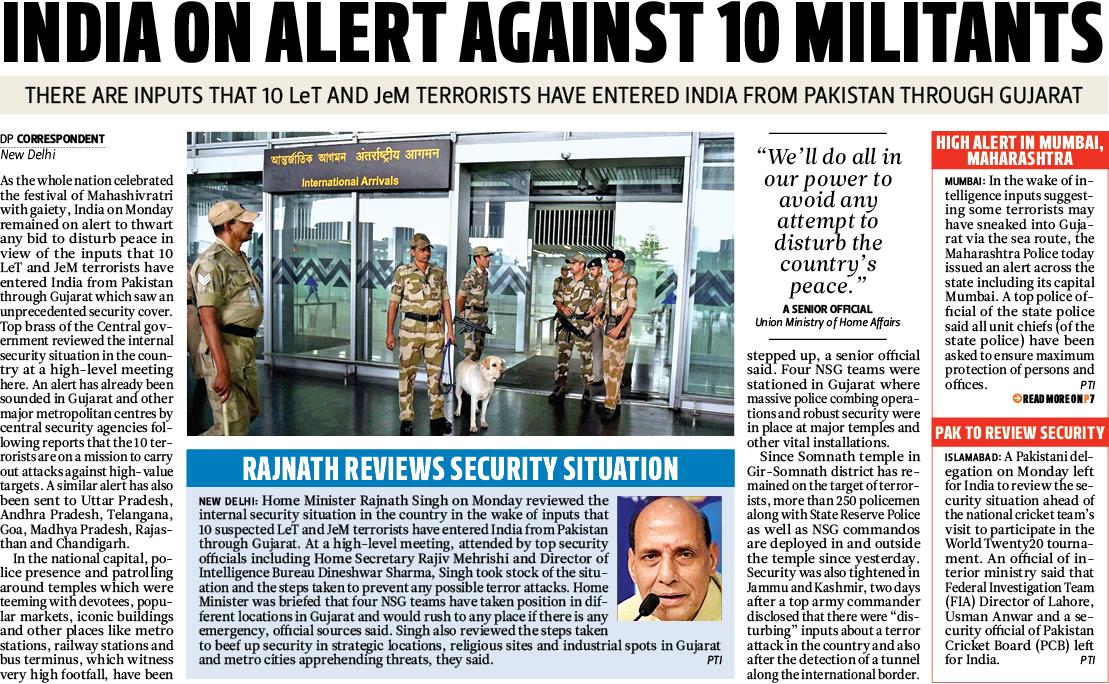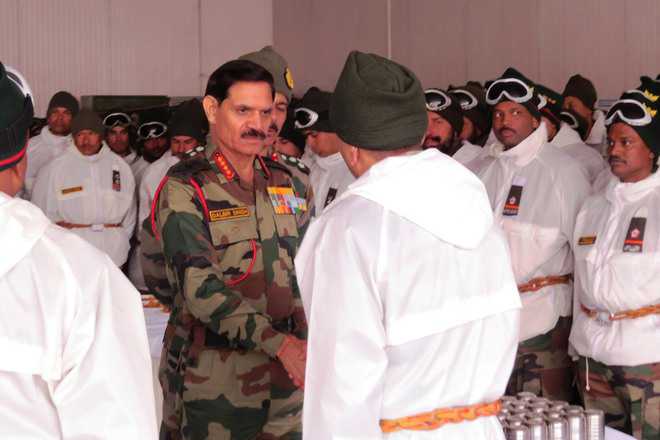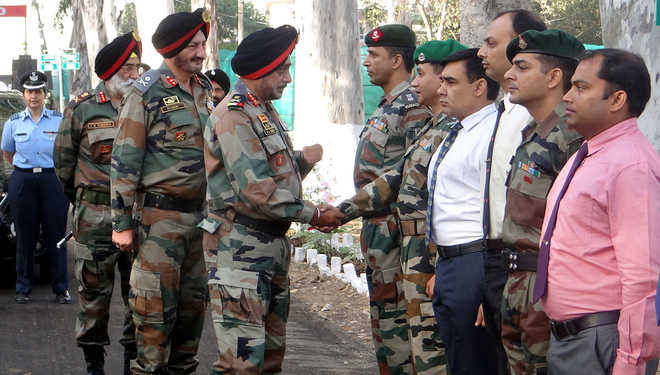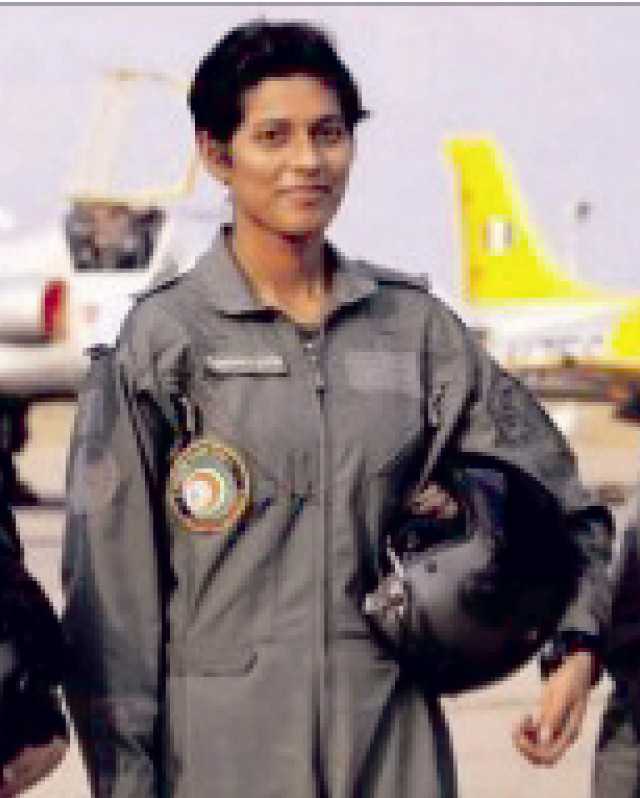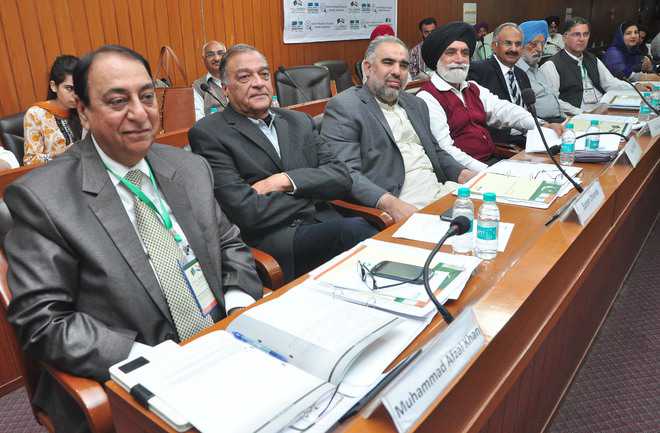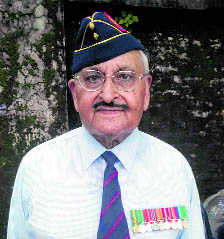 The police keep a vigil at a temple in Surat on Mahashivaratri on Monday. PTI
The police keep a vigil at a temple in Surat on Mahashivaratri on Monday. PTITribune News Service
New Delhi, March 7
Home Minister Rajnath Singh today held a high-level internal security review meeting amid multi-city alert owing to a terror threat following inputs of 10 LeT and JeM terrorists having entered the Indian territory from Pakistan through Gujarat coast. Alert has also been sounded in Chandigarh, Uttar Pradesh, Andhra Pradesh, Telangana, Goa, Madhya Pradesh and Rajasthan.As most temples, keeping in view Mahashivaratri celebration today, and other strategic locations were put under tight vigil, the Home Minister was briefed by officials about the security drill.Singh took stock of the situation and steps taken to prevent any possible terror attacks, though the agencies remained clueless about the location and possible target of the suspected terrorists.Besides National Security Adviser Ajit Doval, other top security officials present at the meeting included Home Secretary Rajiv Mehrishi and Director of Intelligence Bureau Dineshwar Sharma.An alert has already been sounded in Gujarat and other major metropolitan centres by central security agencies following reports that the 10 terrorists are on a mission to carry out attacks against high-value targets. Tier-two cities such as Lucknow, Jaipur, Vijayawada, Bhopal, Chandigarh, Ahmedabad and Panaji have also been asked to step up vigil. Delhi, Mumbai, Hyderabad and Bangalore have already been on alert following the input.In the national Capital, police presence and patrolling have been stepped up around temples, popular markets, iconic buildings and other places such as metro stations, railway stations and bus terminus, a senior official said.After the review meeting, the Home Minister told mediapersons that action had been taken following the intelligence inputs. “We have received some information and whatever necessary instructions had to be given, have been given,” he said.Sources in the MHA said the minister reviewed the steps taken to beef up security at strategic locations, religious sites and industrial spots in Gujarat and metro cities apprehending threats.Kiren Rijiju, junior minister in the MHA, said security agencies were working and taking necessary steps after receiving the intelligence inputs. In view of the January 2 terror attack at the Pathankot airbase, security agencies were not taking any chances and all possible steps are being taken to prevent any possible terror strike, assured the minister. Security was beefed up across Gujarat and in other parts of the country after the National Security Adviser got a call from his Pakistani counterpart Nasir Janjua about the 10 terrorists from two Pakistan-based outfits having sneaked into India through the Gujarat coast.The central agencies are investigating the discovery of five abandoned fishing boats near Sir Creek on the Kutch coast over the past three months, including one found by a BSF patrol on Friday.
(With agency inputs)
RAJNATH REVIEWS SECURITY SITUATION
The home minister on Monday met top intelligence officials in the wake of an input from Pakistan about possible militant infiltration into Gujarat. But 48 hours after the tip-off, security agencies had no information pointing to the presence of a suicide squad. They, however, continued to trawl through voice and data traffic for leads
VIGIL ON SHIVRATRI Rajnath meets top officials in wake of input about possible infiltration by 10 extremists from Pakistan
NEW DELHI: Thousands of people offered prayers in temples across India under tight security to mark Mahashivratri Monday as the Centre put out a multi-city alert for possible strikes by militants believed to have sneaked into the country.
 PTIA security person stands guard at a New Delhi temple on Monday.Union home minister Rajnath Singh met top officials of the Intelligence Bureau and the Research and Analysis Wing (R&AW), in the wake of an input by Islamabad about possible infiltration into Gujarat by 10 extremists from Pakistan. But over 48 hours after the input, the security establishment was yet to get any technical or human intelligence suggesting the presence of a suicide squad but continued to trawl through voice and data traffic for leads.
PTIA security person stands guard at a New Delhi temple on Monday.Union home minister Rajnath Singh met top officials of the Intelligence Bureau and the Research and Analysis Wing (R&AW), in the wake of an input by Islamabad about possible infiltration into Gujarat by 10 extremists from Pakistan. But over 48 hours after the input, the security establishment was yet to get any technical or human intelligence suggesting the presence of a suicide squad but continued to trawl through voice and data traffic for leads.
“We will not lower our guard despite no reports of sightings of any suspicious person or group of persons. We have not got any other evidence that suggests presence of such a group on Indian soil but leaving nothing to chance whole country is on high alert including Gujarat,” said a senior security official involved in monitoring the situation. Sources said the terror threat and security arrangements were discussed by Singh in the presence of national security adviser Ajit Doval, all intelligence chiefs and home secretary Rajiv Mehrishi. “There is a specific Shivratri related terror threat in Jammu and Kashmir. The state is in position of maximum alert along with Gujarat,” said the official.
Sources said a special watch was being kept on the borders of Gujarat. All neighbouring states including Rajasthan and Maharastra were asked to remain vigilant. On Sunday, the Centre had sent 160 National Security Guard commandos to Gujarat, which continued to remain under unprecedented security cover. In Somnath, devotees passed through eight layers of security and policemen on horseback patrolled the beach near the temple. “Apart from Somnath, security has also been beefed up at two other Shiva temples at Bhavnath and Nageshwar,” said Gujarat director general of police PC Thakur. Cities such as Lucknow, Jaipur, Vijaywada, Bhopal, Chandigarh, Ahmedabad and Panaji were alerted about possible attacks besides Mumbai, Hyderabad, Cyberabad and Bengaluru, officials said.
Authorities threw a protective cordon – comprising paramilitary forces, provincial armed constabulary jawans and state police — around Varanasi’s Kashi Vishwanath temple, where 120,000 people offered prayers until noon.
Security was tightened at other prominent religious centres — including Baba Kaal Bhairav temple, Maa Durga temple and Sankatmochan temple — in the city. Police were keeping a close eye on the ‘kanwarias’ – Shiva devotees who carry holy Ganges water for offering at temples — as there was an apprehension that they may be targeted by terror outfits. In Delhi, police presence and patrolling around temples teeming with devotees, popular markets, iconic buildings and other places such as metro stations, railway stations and bus terminus, which witness very high footfall, was stepped up, a senior official said.
